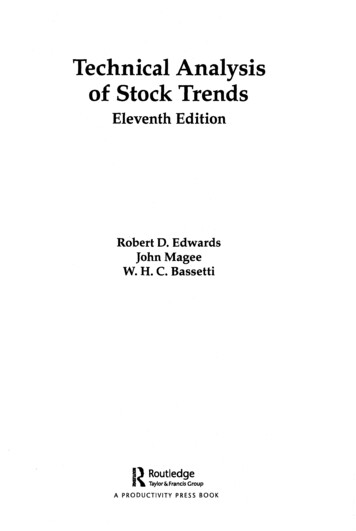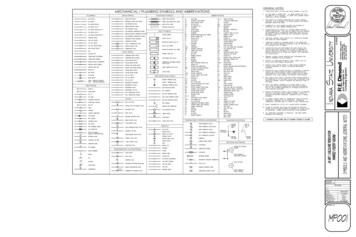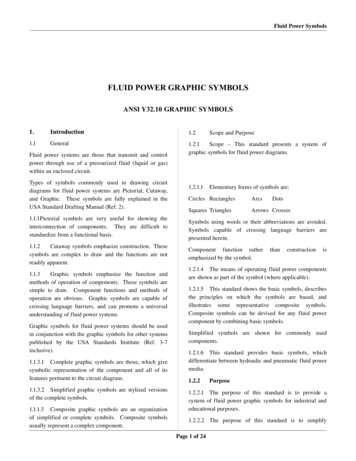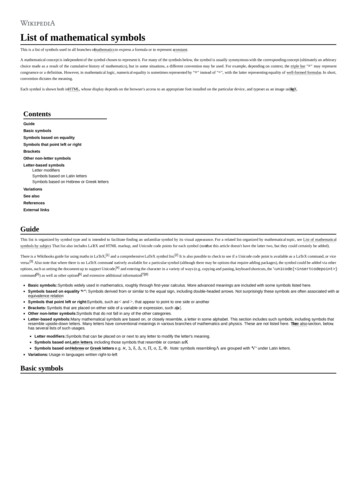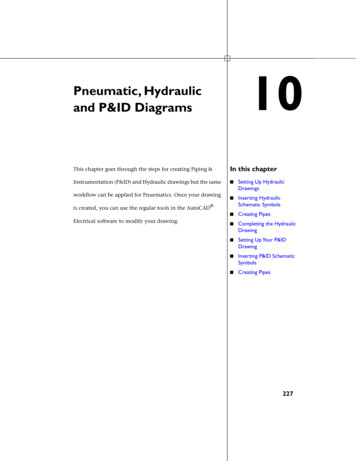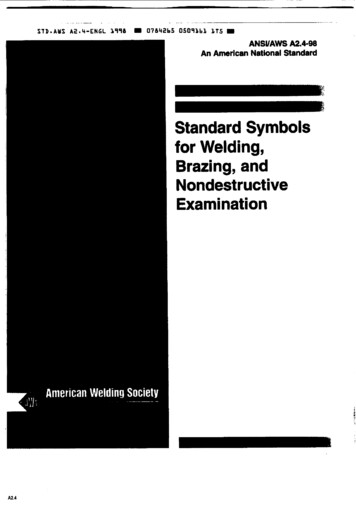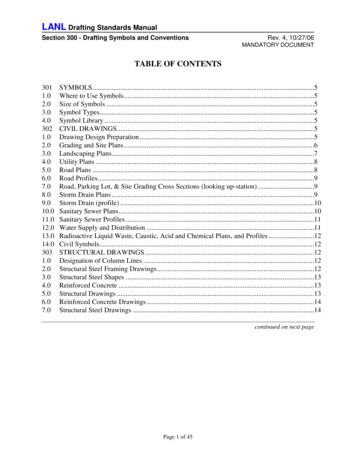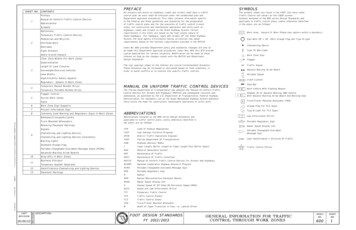
Transcription
SHEET NO. CONTENTSPrefaceManualOn Uniform Traffic ACESYMBOLSAll projects and works on highways, roads and streets shall have a trafficThe symbols shown are found in the FDOT site menu undercontrol plan. All work shall be executed under the established plan andTraffic Control cell library on the CADD system.Department approved procedures. This index contains information specificSymbols assigned to the 600 series Design Standards andto the Federal and State guidelines and standards for the preparationapplicable to traffic control plans, unless otherwise identifiedof traffic control plans and for the execution of traffic control in workin the plans, are as follows:zones, for construction and maintenance operations and utility work onhighways, roads and streets on the State Highway System. CertainWork Area, Hazard Or Work Phase (Any pattern within a boundary)requirements in this Index are based on the high volume nature ofTemporary Traffic ControlDevicesPedestrian and Bicyclist2Overhead WorkState Highways. For highways, roads and streets off the State HighwaySystem, the local agency (City/County) having jurisdiction may adoptSign With 18" x 18" (Min.) Orange Flag And Type B Lightrequirements based on the minimum requirements provided in the MUTCD.Channelizing DeviceRailroadsIndex No. 600 provides Department policy and standards. Changes are only toSightDistancebe made thru Department approved procedures. Index Nos. 601 thru 670 provideAbove Ground HazardType III Barricadetypical applications for various situations. Modification can be made to theseWork Zone SignIndexes as long as the changes comply with the MUTCD and DepartmentClear Zone Widths For Work ZonesDesign Standards.FlaggerThe sign spacings shown on the Indexes are typical (recommended) distances.Traffic SignalSuperelevationLength Of Lane ClosuresThese distances may be increased or decreased based on field conditions, in3Overweight/Oversize VehiclesAdvance Warning Arrow Boardorder to avoid conflicts or to improve site specific traffic controls.Lane WidthsPortable SignalHigh-Visibility Safety Apparelc. c.Crash CushionRegulatory Speeds In Work ZonesStop BarTemporary Raised Rumble StripsMANUAL ON UNIFORM TRAFFIC CONTROL DEVICESTemporary Portable Rumble StripsThe Florida Department of Transportation has adopted the "Manual On Uniform Traffic4Flagger ControlControl Devices For Streets And Highways" (MUTCD) and subsequent revisions andaddendums, as published by the U.S. Department of Transportation, Federal Highway5Survey Work ZonesSignsWork Vehicle With Flashing BeaconWShadow (S) Or Advance Warning (AW) VehicleXWith Advance Warning Arrow Board And Warning SignAdministration, for mandatory use on the State Maintained Highway System wheneverthere exists the need for construction, maintenance operations or utility work.6Work Zone Sign Supports7ProjectInformation Sign8Commonly Used Warning and Regulatory Signs In Work iations assigned to the 600 series Design Standards andATruck/Trailer Mounted Attenuator (TMA)Orange Flag For TCZ SignsType B Light For TCZ SignsLaw Enforcement Officerapplicable to traffic control plans, unless otherwise identified .dgnTruck Mounted AttenuatorsPortable Regulatory Signthe plans, are as follows:Removing PavementMarkingsRadar Speed Display UnitSignalsCFRCode of Federal RegulationsChannelizing and Lighting DevicesCSIPCost Savings Initiative ProposalDTOEDistrict Traffic Operations EngineerFDOTFlorida Department Of TransportationHARHighway Advisory RadioLTaper Length, Buffer Length Or Taper Length Plus Buffer SpaceMASMotorist Awareness System9Channelizing and Lighting Devices ConsistencyPortable Changeable (Variable)Message SignLane Identification Direction Of TrafficWarning LightsStandard Orange FlagPortable Changeable (Variable)Message Signs (PCMS)Advanced Warning Arrow Boards10MOTMaintenance Of TrafficDrop-Offs In Work ZonesMOTCMaintenance Of Traffic CommitteeBusiness EntranceMUTCDManual On Uniform Traffic Control Devices For Streets And HighwaysTemporary Asphalt SeparatorNCHRPNational Cooperative Highway Research ProgramIdentifications-Channelizing and Lighting DevicesPCMSPortable Changeable (Variable) Message SignPRSPortable Regulatory SignRRadiusRPMRaised Retroreflective Pavement MarkerRSDURadar Speed Display UnitTraffic Control ISIO N12/30/201111:45:02 AMrd960rh13SPosted Speed Of Off-Peak 85 Percentile Speed (MPH)SLEOSpeed and Law Enforcement OfficerTTCTemporary Traffic ControlTCPTraffic Control Plan(s)TCZTraffic Control ZonesTMATruck/Trailer Mounted AttenuatorWWidth Of Taper Transition In Feet, i.e., Lateral OffsetDESCRIPTION:INDEXFDOT DESIGN STANDARDSGENERAL INFORMATION FOR TRAFFICFY 2012/2013CONTROL THROUGH WORK ZONESNO.600SHEETNO.1
OVERHEAD WORK CONTINUED.DEFINITIONSOVERHEAD WORKRegulatory Speed (In Work Zones)Work is only allowed over a traffic lane when one of the followingThe maximum permitted travel speed posted for the work zone is indicated by theregulatory speed limit signs. The work zone speed must be shown or noted in theplans. This speed should be used as the minimum design speed to determine runoutlengths, departure rates, flare rates, lengths of need, clear zone widths, taperOPTION 4 (OVERHEAD WORK MAINTAINING TRAFFIC WITHoptions is used:NO ENCROACHMENT BELOW THE OVERHEAD WORK AREA)OPTION 1 (OVERHEAD WORK USING A MODIFIEDTraffic shall be detoured, shifted, diverted or paced as to not encroach in thearea directly below the overhead work operations in accordance with theLANE CLOSURE)appropriate standard index drawing or detailed in the plans. This option applieslengths, crash cushion requirements, marker spacings, superelevation and otherOverhead work using a modified lane closure is allowed if all of the followingsimilar features.conditions are met:a. Beam, girder, segment, and bent/pier cap placement.a. Work operation is located in a signalized intersection andAdvisory Speedb. Form and falsework placement and removal.limited to signals, signs, lighting and utilities.The maximum recommended travel speed through a curve or a hazardous area.Travel Wayto, but not limited to, the following construction activities:c. Concrete placement.b. Work operations are 60 minutes or less.d. Railing construction located at edge of deck.c. Speed limit is 45 mph or less.e.Structure demolition.d. Aerial lift equipment in the work area has high-intensity, rotating, flashing,The portion of the roadway for the movement of vehicles. For traffic controlthrough work zones, travel way may include the temporary use of shoulders andany other permanent or temporary surface intended for use as a lane for theOPTION 5 (CONDUCTOR/CABLE PULLING ABOVE AN OPENoscillating, or strobe lights operating.e. Aerial lift equipment is placed directly below the work area to close theTRAFFIC LANE)lane.Overhead cable and/or de-energized conductor installations initial pull to propermovement of vehicular traffic.f. Traffic control devices are placed in advance of the vehicle/equipmenttension shall be done in accordance with the appropriate Standard Index orclosing the lane using a minimum 100 foot taper.a. Travel Lane: The designated widths of roadway pavement marked to carrythrough traffic and to separate it from opposing traffic or traffic occupyingtemporary traffic control plan.g. Volume or complexity of the roadway may dictate additional devices, signs,flagmen and/or a traffic control officer.Continuous pulling operations of secured cable and/or conductors are allowedother traffic lanes.OPTION 2 (OVERHEAD WORK ABOVE AN OPENb. Auxiliary Lane: The designated widths of roadway pavement marked toseparate speed change, turning, passing and climbing maneuvers fromthrough traffic.A detour is the redirection of traffic onto another roadway to bypass theA lane shift is the redirection of traffic onto adifferent section of the permanent pavement. A diversion is the redirection oftraffic onto a temporary roadway, usually adjacent to the permanent roadway andwithin the limits of the right of way.Above Ground HazardAn above ground hazard is any object, material or equipment other than trafficcontrol devices that encroaches upon the travel way or that is located withinthe clear zone which does not meet the Department’s safety criteria, -02.dgnanything that is greater than 4" in height and is firm and unyielding or doesn’tmeet breakaway requirements.the travel way. The utility shall take precautions to ensure that pull ropes andOverhead work above a open traffic lane is allowed if all of the followinga. Work operation is located on a utility pole, light pole, signal pole, ortheir appurtenances.across the roadway.d. No encroachment by any part of the work activities and equipmentb. During pulling operations, advance warning consisting of no less than awithin an area bounded by 2 feet outside the edge of travel way andChangeable Message Sign upstream of the work area with alternating messages,18 feet high."Overhead Work Ahead" and "Be Prepared to Stop" followed by a traffic controle. Aerial lift equipment in the work area has high-intensity, rotating,officer and police vehicle with blue lights flashing during the pulling operation.flashing, oscillating, or strobe lights operating.f. Volume or complexity of the roadway may dictate additional devices,RAILROADSsigns, flagmen and/or a traffic control officer.g. Adequate precautions are taken to prevent parts, tools, equipment andother objects from falling into open lanes of traffic.Railroad crossings affected by a construction project should be evaluated for trafficcontrols to reduce queuing on the tracks. The evaluation should include as a minimum:greater clearance. The greater clearance required prevails as the rule.TEMPORARY TRAFFIC CONTROL DEVICESOn Limited Access facilities, a site specific temporary traffic control plan isa. The temporary traffic control set up for the initial pulling of the pull ropec. Speed limit is 45 mph or less.traffic volumes, distance from the tracks to the intersections, lane closure or taperlocations, signal timing, etc.OPTION 3 (OVERHEAD WORK ADJACENT TO AN OPENAll temporary traffic control devices shall be on either the Department’s QualifiedProduct List (QPL) or the Department’s Approved Products List (APL). Ensure theTRAFFIC LANE)SIGHT DISTANCEappropriate QPL or APL number is permanently marked on the device in a readilyOverhead work adjacent to an open traffic lane is allowed if all of theTapers: Transition tapers should be obvious to drivers. If restricted sight distance is avisible location.following conditions are met:problem (e.g., a sharp vertical or horizontal curve), the taper should begin well ina. Work operation is located on a utility pole, light pole, signal pole, or theirAll temporary traffic control devices shall be removed as soon as practical whenadvance of the view obstruction. The beginning of tapers should not be hidden behindcurves.appurtenances.they are no longer needed. When work is suspended for short periods of time,b. Work operations are 1 day or less.temporary traffic control devices that are no longer appropriate shall be removedc. Speed limit is 45 mph or less.Intersections: Traffic control devices at intersections must provide sight distances foror covered.d. No encroachment by any part of the work activities and equipment withinthe road user to perceive potential conflicts and to traversethe intersection safely.2 foot from the edge of travelway up to 18’ height.Arrow Boards, Portable Changeable Message Signs, Radar Speed Display Trailer,Above 18’ in height, no encroachment by any part of the work activitiesPortable Regulatory Signs, and any other trailer mounted device shall be delineatedand equipment over the open traffic lane (except as allowed in Option 2with a temporary traffic control device placed at each corner when in use and shallfor work operations of 60 minutes or less).crash cushion when not in use.flashing, oscillating, or strobe lights operating.When an existing pedestrian way or bicycle way is located within a traffic control workzone, accommodation must be maintained and provision for the disabled must be provided.hours and treated with appropriate work zone traffic control procedures. Duringnonworking hours, all objects, materials and equipment that constitute an above groundf. Volume or complexity of the roadway may dictate additional devices,PEDESTRIAN AND BICYCLISTABOVE GROUND HAZARDAbove ground hazards (see definitions) are to be considered work areas during workinge. Aerial lift equipment in the work area has high-intensity, rotating,signs, flagmen and/or a traffic control officer.11:45:02 AMconductors/cables at no time fall below the minimum vertical clearance.required. The temporary traffic control plan shall include:b. Work operations are 60 minutes or less.h. Other Governmental Agencies, Rail facilities, or Codes may require abe moved outside the travel way and clear zone or be shielded by a barrier orrd960rhactivities, materials or equipment within the minimal vertical clearance aboveTRAFFIC LANE)conditions are met:Detour, Lane Shift, and Diversiontemporary traffic control zone.over open lane(s) of traffic with no encroachment by any part of the workhazard must be stored/placed outside the travel way and clear zone or be shielded bya barrier or crash cushion.g. Adequate precautions are taken to prevent parts, tools, equipment andother objects from falling into open lanes of traffic.For above ground hazards within a work zone the clear zone required should be basedh. Other Governmental Agencies, Rail facilities, or Codes may require aon the regulatory speed posted during construction.greater clearance. The greater clearance required prevails as the rule.Only approved temporary traffic control devices may be used to delineate a temporaryOVERHEAD WORK CONTINUED.Advanced notification of sidewalk closures and marked detours shall be provided byappropriate signs.LASTREVISION01/01/10REVISIO N12/30/2011traffic control zone pedestrian walkway.DESCRIPTION:INDEXFDOT DESIGN STANDARDSGENERAL INFORMATION FOR TRAFFICFY 2012/2013CONTROL THROUGH WORK ZONESNO.600SHEETNO.2
CLEAR ZONE WIDTHS FOR WORK ZONESOVERWEIGHT/OVERSIZE VEHICLESThe term ’clear zone’ describes the unobstructed relatively flat area, impacted byRestrictions to Lane Widths, Heights or Load Capacity can greatlyconstruction, extending outward from the edge of the traffic lane. The tableimpact the movement of over dimensioned loads. The Contractorbelow gives clear zone widths in work zones for medians and roadside conditionsshall notify the Engineer who in turn shall notify the State Permitsother than for roadside canals; where roadside canals are present, clear zoneOffice, phone no. (850) 410-5777, at least seven calendar days inwidths are to conform with the distances to canals as described in Volume I,advance of implementing a maintenance of traffic plan which willChapter 4, Section 4.2 and Exhibit 4-A and 4-B of the Plans Preparation Manual.REGULATORY SPEEDS IN WORK ZONESTraffic Control Plans (TCP’s) for all projects must include specific regulatoryspeeds for each phase of work. This can either be the posted speed or a reducedspeed. The speed shall be noted in the TCPs; this includes indicating the existingspeed if no reduction is to be made. Regulatory speeds are to be uniformlyestablished through each phase.impact the flow of overweight/oversized vehicles. InformationIn general, the regulatory speed should be established to route vehicles safelyprovided shall include location, type of restriction (height, width orthrough the work zone as close as to normal highway speed as possible. Theweight) and restriction time frames. When the roadway is restoredregulatory speed should not be reduced more than 10 mph below the posted speedto normal service the State Permits Office shall be notifiedand never below the minimum statutory speed for the class of facility. When aimmediately.speed reduction greater than 10 mph is imposed, the reduction is to be done in 10mph per 500’ increments.CLEAR ZONE WIDTHS FOR WORK ZONESTRAVEL LANES &AUXILIARY LANES &MULTILANE RAMPSSINGLE LANE RAMPS(feet)(feet)3018WORK ZONE SPEED(MPH)60-7055241445-501810Temporary regulatory speed signs shall be removed as soon as the conditionsLANE WIDTHSrequiring the reduced speed no longer exist. Once the work zone regulatory speedsLane widths of through roadways should be maintained through workare removed, the regulatory speed existing prior to construction will automaticallyzone travel ways wherever practical. The minimum widths for work zonego back into effect unless new speed limit signing is provided for in the plans.travel lanes shall be as follows: 11’ for Interstate with at least one 12’lane provided in each direction, unless formally excepted by the FederalOn projects with interspaced work activities, speed reductions should be located inHighway Administration; 11’ for freeways; and 10’ for all otherproximity to those activities which merit a reduced speed, and not "blanketed" forfacilities.30-4014104’ BEHIND FACE4’ BEHIND FACEOF CURBOF CURBthe entire project. At the departure of such activities, the normal highway speedshould be posted to give the motorist notice that normal speed can be resumed.ALL SPEEDSCURB & GUTTERHIGH-VISIBILITY SAFETY APPARELIf the existing regulatory speed is to be used, consideration should be given toAll high-visibility safety apparel shall meet the requirements of the InternationalSafety Equipment Association (ISEA) and the American National Standards Institute(ANSI) for High-Visibility Safety Apparel", and labeled as ANSI/ISEA 107-2010. Theapparel background (outer) material color shall be either fluorescent orange-redSUPERELEVATIONor fluorescent yellow-green as defined by the standard. The retroreflectiveHorizontal curves constructed in conjunction with work zone trafficmaterial shall be orange, yellow, white, silver, yellow-green, or a fluorescentcontrol should have the required superelevation applied to the designversion of these colors, and shall be visible at a minimum distance of 1,000 feet.radii. Under conditions where normal crown controls curvature,Class 3 apparel may be substituted for Class 2 apparel. Replace apparel that isthe minimum radii that can be applied are listed in the table below.not visible at 1,000 feet.supplementing the existing signs when the construction work zone is betweenexisting regulatory speed signs. For projects where the reduced speed conditionsexist for greater than 1 mile in rural areas (non-interstate) and on rural or urbaninterstate, additional regulatory speed signs are to be placed at no more than 1mile intervals. Engineering judgement should be used in placement of the additionalsigns. Locating these signs beyond ramp entrances and beyond major intersectionsare examples of proper placement. For urban situations (non-interstate), additionalspeed signs are to be placed at a maximum of 1000’ apart.When field conditions warrant speed reductions different from those shown in 3.dgnWORKERS: All workers within the right-of-way shall wear ANSI/ISEA Class 2MINIMUM RADII FORapparel. Workers operating machinery or equipment in which loose clothing couldbecome entangled during operation shall wear fitted high-visibility safety apparel.NORMAL CROWNWORK ZONEMINIMUM RADIUSWorkers inside the bucket of a bucket truck are not required to wear high-visibilityfeetUTILITIES: When other industry apparel safety standards require utility workers to653130wear apparel that is inconsistent with FDOT requirements such as NFPA, OSHA,ANSI, etc., the other standards for apparel may prevail.240018401390FLAGGERS: For daytime activities, Flaggers shall wear ANSI/ISEA Class 2 apparel.1080For nighttime activities, Flaggers shall wear ANSI/ISEA Class 3 apparel.82061030430plates will be used at the option of the field engineer for temporary use whileprocessing a request to change the regulatory speed specified in the plans whenbelow the construction warning sign for which the advisory speed is required.5040request the District Traffic Operations Engineer (DTOE) to investigate the need. Itdeemed necessary. Advisory speed plates cannot be used alone but must be placed4535posted speed, or, the engineer maywork zones due to the revised provisions of F.S. 316.07451(2) (b). Advisory SpeedMPH60Department, a signed and sealed study to justify the need for further reducing thewill not be necessary for the DTOE to issue regulations for regulatory speeds insafety apparel.POSTED SPEED55TCP the contractor may submit to the project engineer for approval by theFor additional information refer to the FDOT Plans Preparation Manual, Volume I,Chapter 10.Superelevate When SmallerLENGTH OF LANE CLOSURESLane closures shall not exceed 2 miles in total length (taper, bufferspace and work space) in any given direction on the Interstate oron state highways with a posted speed of 55 MPH or greater.LASTREVISION01/01/12REVISIO N12/30/201111:45:04 AMrd960rhRadii is UsedDESCRIPTION:INDEXFDOT DESIGN STANDARDSGENERAL INFORMATION FOR TRAFFICFY 2012/2013CONTROL THROUGH WORK ZONESNO.600SHEETNO.3
Temporary Raised Rumble Strip StrietpsShoPeulrdeSetrEdTrav geOfelWayneLiee)tidghEW(neilertn)Ce lowlYe(BEPREPAREDTO STOPONE LANEROADAHEAD45’(–TYPICAL PLACEMENT OF TEMPORARY RAISED RUMBLE STRIPS1")ctocREMOVABLE POLYMER RUMBLE STRIP SET(PAVED SHOULDER 0-04.dgnTemporary Portable Rumble Strip DAHEADnIPavedneLa1")ctoTYPICAL PLACEMENT OF TEMPORARY INTERNALLY BALLASTED RUMBLE STRIPS1SStrietpsShoPeulrdeSetr12"EdTrav geOfelWayneLiee)tdghiEW(neilertn)Ce lowlYe(cBEPREPAREDTO STOPONE LANEROADAHEAD3MOLDED ENGINEERED POLYMER RUMBLE STRIP SETrd960rh(PAVED SHOULDER SHOWN)DISTANCE BETWEEN SIGNSGENERAL NOTESSpacing (ft.)11:45:05 AMSpeed(mph)ABCD40 or less200200200100453503503501755050050050025055 or greater500164010005001. Temporary rumble strips sets shall be placed in advance of each flagging station whencalled for in the plans.12/30/20112. Temporary rumble strip sets are used to supplement a series of advanced warning signsand shall be installed and removed when the signs are installed and removed.LASTREVISION01/01/12REVISIO N3. Remove the temporary rumble strips prior to removing the advance warning signs.DESCRIPTION:INDEXFDOT DESIGN STANDARDSGENERAL INFORMATION FOR TRAFFICFY 2012/2013CONTROL THROUGH WORK ZONESNO.600SHEETNO.4
FLAGGER CONTROLSurvey Between Active Traffic LanesSIGN COVERING AND INTERMITTENT WORK STOPPAGE SIGNINGWhere flaggers are used, a FLAGGER symbol or legend sign must replace theor Shared Left Turn LanesExisting or temporary traffic control signs that are no longer applicable or are inconsistentWORKERS symbol or legend sign.The following provisions apply to Main Roadway Traffic Control Work Zones. Thesewith intended travel paths shall be removed or fully covered.provisions must be adjusted by the Party Chief to fit roadway and trafficThe flagger must be clearly visible to approaching traffic for a distance sufficientSign blanks or other available coverings must completely cover the existing sign. Rigid signconditions when the Survey Work Zone includes intersections.to permit proper response by the motorist to the flagging instructions, and topermit traffic to reduce speed or to stop as required before entering the worksite. Flaggers shall be positioned to maintain maximum color contrast between thecoverings shall be the same size as the sign it is covering, and bolted in a manner to prevent(A) A STAY IN YOUR LANE (MOT-1-06) sign shall be added to the Advance WarningSign sequence as the second most immediate sign from the work area.Flagger’s high-visibility safety apparel and equipment and the work areabackground.movement.Sign covers are incidental to work operations and are not paid for separately.(B) Elevation Surveys-Cones may be used at the discretion of the Party Chief toHand-Signaling Devicesprotect prism holder and flagger(s). Cones, if used, may be placed at up to 50’SIGNING FOR DETOURS, LANE SHIFTS AND DIVERSIONSintervals along the break line throughout the work zone.Detours should be signed clearly over their entire length so that motorists can easilySTOP/SLOW paddles are the primary hand-signaling device. The STOP/SLOW paddleshall have an octagonal shape on a rigid handle. If the STOP/SLOW paddle isdetermine how to return to the original roadway. The reverse curve (W1-4) warning sign(C) Horizontal Control-With traffic flow in the same direction, cones shall be usedplaced on a rigid staff, the minimum length of the staff, measured from the bottomto protect the backsight tripod and/or instrument. Cones shall be placed at theof the paddle to the end of the staff that rests on the ground, should be 7 ft.equipment, and up to 50’ intervals for at least 200’ towards the flow of traffic.STOP/SLOW paddles shall be at least 24 inches wide with letters at least 6 inchesshould be used for the advanced warning for a lane shift. A diversion should besigned as a lane shift.EXTENDED DISTANCE ADVANCE WARNING SIGNhigh and should be fabricated from light semirigid material. The background of the(D) Horizontal Control-With traffic flow in opposite directions, cones shall be usedSTOP face shall be red with white letters and border. The background of the SLOWto protect the backsight tripod and/or instrument. Cones shall be placed at theAdvance Warning Signs shall be used at extended distance of one-half mile or more whenface shall be orange with black letters and border. When used at night-time, theequipment, and up to 50’ intervals for at least 200’ in both directions towardslimited sight distance or the nature of the obstruction may require a motorist to bringSTOP/SLOW paddle shall be retroreflectorized.the flow of traffic.their vehicle to a stop. Extended distance Advanced Warning Signs may be required onany type roadway, but particularly be considered on multilane divided highways whereFlag use is limited to immediate emergencies, intersections, and when working onvehicle speed is generally in the higher range (45 MPH or more).SIGNSthe centerline or shared left turn lanes where two (2) flaggers are required andthere is opposing traffic in the adjacent lanes. Flags, when used, shall be aminimum of 24 inches square, made of a good grade of red material, and securelySIGN MATERIALSUTILITY WORK AHEAD SIGNMesh signs may be used only for Daylight Operations.The UTILITY WORK AHEAD (W21-7) sign may be used as an alternate to the ROAD WORKfastened to a staff that is approximately 36 inches in length. When used atnighttime, flags shall be retroreflectorized red.AHEAD or the ROAD WORK XX FT (W20-1) sign for utility operations on or adjacent to aVinyl signs may be used for Day or Night Operations not to exceed 1 day excepthighway.as noted in the standards.Flashlight, lantern or other lighted signal that will display a red warning light shallbe used at night.LENGTH OF ROAD WORK SIGNRigid or Lightweight sign panels may be used in accordance with the vendorThe length of road work sign (G20-1) bearing the legend ROAD WORK NEXT MILES isdrawing for the sign stand to which they are attached.required for all projects of more than 2 miles in length. The number of miles enteredFlagger Stationsshould be rounded up to the nearest mile. The sign shall be located at begin constructionFlagger stations shall be located far enough in advance of the work space so thatapproaching road users will have sufficient distance to stop before entering 5.dgnwork space. When used at nighttime, the flagger station shall be illuminated.INTERSECTING ROAD SIGNINGpoints.Signing for the control of traffic entering and leaving work zones by way ofintersecting crossroads shall be adequate to make drivers aware of work zoneSPEEDING FINES DOUBLED WHEN WORKERS PRESENT SIGNconditions. If work operations exceed 60 minutes, intersection leg signing will beSURVEY WORK ZONESThe SPEEDING FINES DOUBLED WHEN WORKERS PRESENT sign should be installed on allno less than the ROAD WORK AHEAD sign.projects, but may be omitted if the work operation is less than 1 day. The placementThe SURVEY CREW AHEAD symbol or legend sign shall be the principal AdvanceWarning Sign used for Traffic Control Through Survey Work Zones and may replacethe ROAD WORK AHEAD sign when lane closures occur, at the discretion of theParty Chief. Dual orange flags shall be used at all times to enhance the SURVEYCREW AHEAD sign, even with mesh signs.should be 500 feet beyond the ROAD WORK AHEAD sign or midway to the next signADJOINING AND/OR OVERLAPPING WORK ZONE SIGNINGsigns and other traffic control devices in their advance warning areas or in somethe END ROAD WORK sign as called for on certain 600 Series Indexes should beomitted.GROOVED PAVEMENT AHEAD SIGNcases other areas within their traffic control zones. Where such restraints orconflicts occur or are likely to occur, one of the following methods will be employedWhen Traffic Control Through Work Zones is being used for survey purposes only,whichever is less.Adjoining work zones may not have sufficient spacing for standard placement ofto avoid conflicts and prevent conditions that could lead to misunderstanding on thepart of the traveling public as to the intended travel way by the traffic controlThe GROOVED PAVEMENT AHEAD sign is required 500 feet in advance of a milled orgrooved surface open to traffic. The W8-15P placard shall be used in conjuction withthe GROOVED PAVEMENT AHEAD sign.proce
d.No encroachment by any part of the work activities and equipment within c.Speed limit is 45 mph or less. b.Work operations are 1 day or less. appurtenances. a.Work operation is located on a utility pole, light pole, signal pole, or their following conditions are met: Overhead work adjacent to an open traffic lane is allowed if all of the



